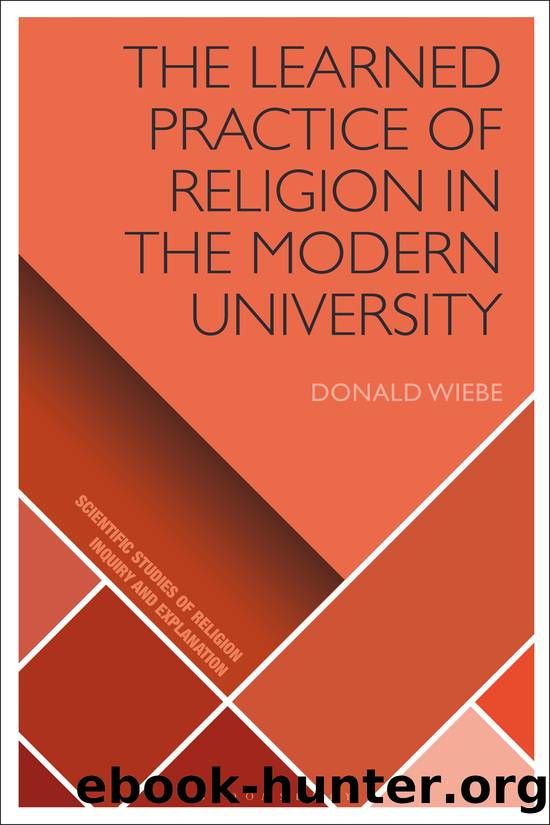Learned Practice of Religion in the Modern University by Donald Wiebe;

Author:Donald Wiebe;
Language: eng
Format: epub
ISBN: 9781350103450
Publisher: Bloomsbury UK
9
American Influence on the Shape of Things to Come
Introduction
I consider it a great honor to address the Korean Association for the Study of Religion on the future of “Religious Studies”—Religionswissenschaft—in the twenty-first century, with special focus on the trends in the discipline in the United States of America.
The overall theme for this conference is sweeping, to say the least, and tempts one to play the role of prophet or seer predicting the shape of the discipline in the twenty-first century. Although we may be able to sense developments that are likely to occur, reliable predictions about the field as a whole are beyond our capacity. Speculation may not be entirely without merit, however, for trying to read the implications of current trends in the field may provide the impetus to seek greater clarity and precision in a discipline that has since its emergence been ambiguously (and therefore problematically) related to its object of interest. With that in mind, I shall argue here that the modern study of religion, shaped by the likes of Friedrich Max Müller, Cornelis P. Tiele and others in the latter part of the nineteenth century, and clearly represented by the mandate of the IAHR, stands in jeopardy; to put the matter more provocatively, a decline in the global health of the discipline has already occurred and will continue because of the phenomenal growth of the study of religion in the American context since the Second World War, and particularly with the formidable power of the AAR.
At one level such a thesis may appear preposterous given the obvious strengths of the field in the United States. For there exist today more than 1,200 departments of religious studies, more than a score of societies and associations devoted to research and scholarship on religion and religions, and well over 15,000 scholars in American colleges and universities who count themselves as students of religion in some sense or other. With this vast increase in persons engaged in the field since the Second World War, there has been a concomitant increase in the volume of research, coupled with an expansion of the field’s boundaries to include non-Western religious traditions. With increased numbers has come the development of specializations that have enriched the field by encouraging a depth of knowledge in a wide range of religious issues and themes. As well, the concern for academic legitimation within the university community has actually stimulated growth in methodological reflection about the field. Yet despite these achievements, I shall contend that “the academic study of religion” in the United States has advanced little in its self-definition beyond that which characterized it during the early stages of the modern research university. And it is the precise disparity between its tremendous growth in size, wealth, and power and its failure to re-conceive the field in the new setting of the research university that ought to promote serious thought to its future impact on the field globally. In order to justify my stance, of course, it will be
Download
This site does not store any files on its server. We only index and link to content provided by other sites. Please contact the content providers to delete copyright contents if any and email us, we'll remove relevant links or contents immediately.
The Lost Art of Listening by Michael P. Nichols(6469)
Why I Am Not A Calvinist by Dr. Peter S. Ruckman(3768)
The Rosicrucians by Christopher McIntosh(3049)
Wicca: a guide for the solitary practitioner by Scott Cunningham(2704)
Signature in the Cell: DNA and the Evidence for Intelligent Design by Stephen C. Meyer(2499)
Real Sex by Lauren F. Winner(2473)
The Holy Spirit by Billy Graham(2413)
To Light a Sacred Flame by Silver RavenWolf(2353)
The End of Faith by Sam Harris(2286)
The Gnostic Gospels by Pagels Elaine(2025)
Nine Parts of Desire by Geraldine Brooks(2005)
Waking Up by Sam Harris(1956)
Heavens on Earth by Michael Shermer(1953)
Devil, The by Almond Philip C(1898)
Jesus by Paul Johnson(1887)
The God delusion by Richard Dawkins(1847)
Kundalini by Gopi Krishna(1823)
Chosen by God by R. C. Sproul(1758)
The Nature of Consciousness by Rupert Spira(1688)
